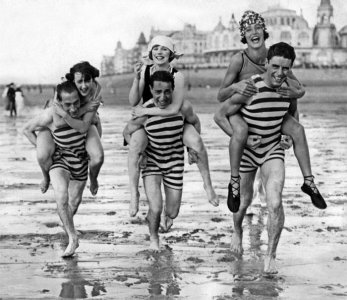The stripes
in the fashion world have made a long way of evolution - from
"stigma" of criminals and lepers to a symbol of emancipation and
freedom from prejudices. Today, stripes are a bright fashionable print that
conquers the world podiums again and again. Designers often borrow ideas for
fashion experiments from animals, whose striped outfits are distinguished by an
incredible variety of shapes and colors. The new exhibition at the Darwin
Museum tells about the stripes and their significance in the animal world.
The
carnivorous print defined the fashion of the 1990s through bold experiments of
designers Gianni Versace and Roberto Cavalli, who sought to hightlight the
uninhibited and natural magnetism of women. In 2022, the Year of the Tiger, the
tiger print is back on. In nature the stripes perfectly camouflage this
predator in high grass, among shrubs and trees. Moreover, the pattern of
stripes is individual for each tiger like human fingerprints and is duplicated
on both fur and skin. At the exhibition you will see the white tigress Kali –
the legend of the Moscow Zoo with rare deviation in coloration. There are only
about 130 such tigers in the world, and this is the only specimen in the
collection of the Darwin Museum.
But it is
still unknown for certain why zebra has stripes. Scientists have advanced four
hypotheses, in particular: that the stripes are a camouflage against predators,
a means of thermoregulation, a natural “repellent” from the bites of
blood-sucking insects or a means of recognizing each other. People noticed
zebra coloration and began to use it as a fashionable print in the 50s of the
last century, and in the 60s it was already everywhere: on hats, coats, evening
dresses and sweaters. At the exhibition you will be able to compare the color
of different types of zebras and also find out the answer to the question: what
color is zebra - black with white stripes or vice versa?
The stripes
are multifunctional. Most often they help animals to disguise themselves, warn
them of danger or allow them to exchange signals. But there are exceptions. For
example, popular aquarium fish neon tetra has strips, which create the effect
of glow. Bright stripes of cleaner shrimp serve as self-promotion: they attract
marine fish that want to get rid of parasites. Amazing examples of the use of
stripes in nature are presented at the exhibition not only by natural science
exhibits, but also by works of art from the rich collection of the Darwin
Museum. You can also experience the effects of the stripes yourself by looking
at the striped visual illusions.
Stripes
show great importance not only in nature, but also in the human world. The
exhibition tells the story of stripes from the devil's symbol to fashionable
classics, from gondoliers' uniforms to workers' overalls. Modern striped trends
are represented by costumes of modern Russian designers.

Herd of
zebras

Three
couples have fun on the beach of Ostend, Normandy, July 1, 1938

Italian bug
Graphosoma lineatum. Moscow region. Photo by Petr Bogomazov

Harlequin land crab Gecarcinus quadratus

Sanchetia

Venetian
gondolier

Swiss Guard
- the armed forces of the Vatican














